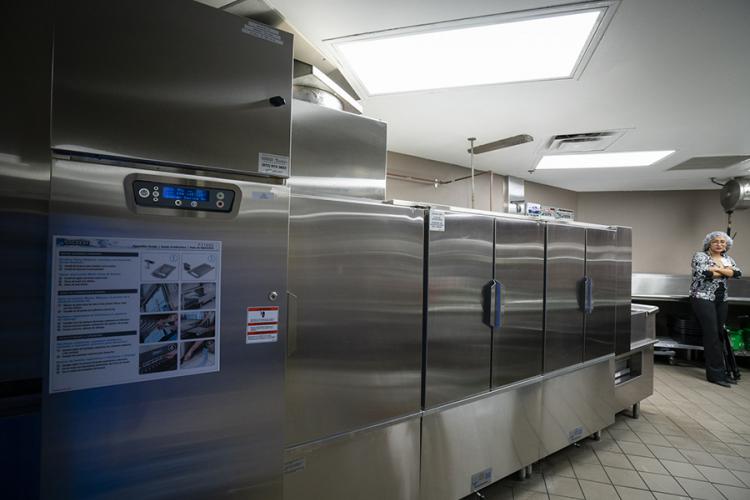
It’s not a shiny new car. It’s a dishwasher.
But if the new JPS Health Network dish machine was an auto, it would certainly be fuel-sipping hybrid with all the latest safety features compared to the worn out Edsel it replaced.
“Our previous dishwasher was an older model at the time we bought it,” said Erica Estrella, manager of patient meal services in the Nutritional Services Department at JPS. “So, as the years went by and it started to break more often, parts were difficult to find because of its age. It just wasn’t able to reliably do the job we needed it to do anymore, so it had to go.”
Following breakfast, lunch and dinner every day, the new dishwasher churns to life to scrub plates, food service domes, bowls, silverware, cooking pots, baking pans and glasses. It takes a four-person team of bussers to constantly load trays of dirty dishes onto the machine’s conveyor on one end and catch the racks of clean dishes that come out the other. Every dish dirtied to make a meal for the patients in the 578 beds at JPS can be cleaned in 90 minutes. Then the process is ready to start all over again.
The machine can run its conveyor at up to 8.5 feet per minute as its contents are bombarded with jets of hot water that scrubs away food remnants. At that speed, it can wash a maximum of 14,316 dishes per hour. If a person washed those dishes by hand spending 15 seconds on each item, it would take almost 60 hours to wash all those plates, pots and pans.
The new model is cheaper to operate not only because it works faster. It also works smarter with a heat exchange system that uses pipes containing hot water exiting the machine to warm incoming cold water pipes. The system can cut down the amount of energy it takes to heat water to operating temperature by as much as 90 percent. According to the manufacturer, the washer could save up to $26,000 in the amount of energy it takes to run for a year compared to older models. At that rate, it would more than pay for itself in about five years.
In addition to being more efficient, the new dishwasher is safer for patients and team members alike.
It heats water from 180-200 degrees to sanitize everything running through it.
“We rely on it being able to get up to the temperatures we need,” Estrella said. “If it doesn’t, we can be assured the dishes are properly cleaned. Then we would have to use disposable dishes” which is expensive and a poor use of resources.
On occasion, while waiting for a scarce part needed to repair the old dishwasher, disposable plates, utensils and cups had to be used for a month at a time.
Unlike the previous machine, the new one is insulated. That means workers don’t constantly get burned from bumping against the washer while trying to load and unload it. Bussers appreciate that because it’s no longer hotter in the dish room than it is outside in July.
The new machine also includes a dryer that saves labor because dishes don’t have to be hand dried. Putting them away wet is a health department no-no.
“The new dish machine works great,” Estrella said. “It helps us do our job of taking care of patients better and more efficiently. That’s really what it’s all about.
